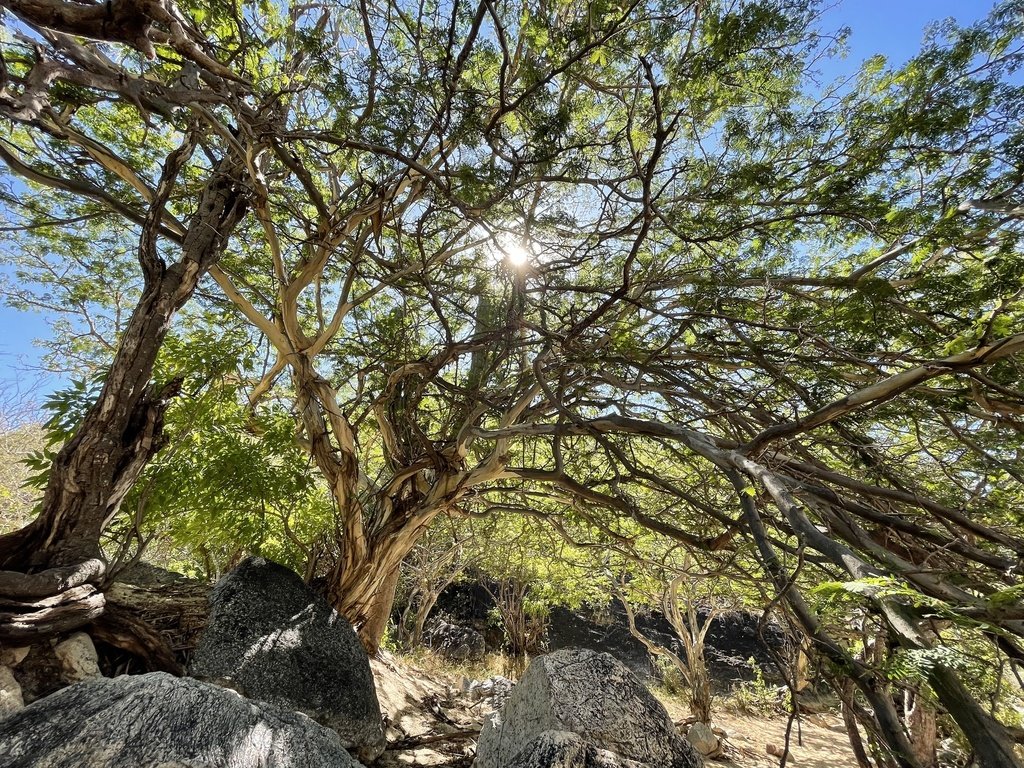Palo Pinto
Chloroleucon mangense var. leucospermum
Family: Fabaceae
OTHER NAMES
Spanish: palo fierro, palo ébana
CHARACTERISTICS
Large evergreen shrub or small tree reaching about 20’ tall. White pin-cushion flowers in spring followed by crinkly legume pods. The bark begins green but after peeling the trunk is layered with dark and light browns—gorgeous mottled trunks. Branches are thorny.
LANDSCAPE USE
Screening shrub or small shade tree.
Photo of Chloroleucon mangense var. leucospermum at University of Arizona Arboretum
GROWING CONDITIONS
AN EXPLANATION OF TERMS USED
SUN full to part sun
WATER moderate to low
SOIL not picky, but well-drained
HARDINESS protect from frost, temperatures in the high 20s°F. will damage leaves and twigs
BASIN high zone
CONTAINER does moderately well in containers but will not attain full size
NUTRITION low
MAINTENANCE very little
ECOLOGY
The trunk is often hollow inside, providing a shelter for many invertebrates, and small mammals. The wood of Chloroleucon mangense is very sought after for firewood and is used in construction to make durable posts.
ETHNOBOTANY
The beans and leafage are often a food source for certain livestock, as well as shade for the livestock as well.
NATURAL DISTRIBUTION
This species is native from Mexico to South America, but this variety is from Sonora and Baja California.
TAXONOMY AND NAME
This plant is in the Fabaceae, the legume family. Chloroleucon has 11 species native to the tropical Americas, ranging from Mexico through Central America, the Caribbean, and South America to northern Argentina.
Formerly known as Pithecellobium leucospermum and P. undulatum.
The genus name Chloroleucon is derived from the Greek words chloros, meaning "green," and leukos, meaning "white." This perhaps refers to the colors from the branches and trunk (begining green and ending up whitish in some species). We are unsure of what the species mangense is referring to, perhaps the plant has a relationship with the mineral manganese? The variety name “leucospermum” is compounded from the Greek words leukos meaning white, and sperma meaning seed, so "white seed".
Chloroleucon mangense var. leucospermum on iNaturalist
Chloroleucon mangense var. leucospermum at the UA Campus Arboretum where you can see one of the few plants in cultivation in the United States
Flowers of Chloroleucon mangense var. leucospermum. Photo by Francisco Farriols Sarabia, iNaturalist
These plants have remarkable, mottled trunks. Photo by Eric Hough, iNaturalist
Plants often have wide-spreading canopies. Photo by Glenn Ehrenberg, iNaturalist
The legume pods are long and crinkly, photo by jrebman, iNaturalist





